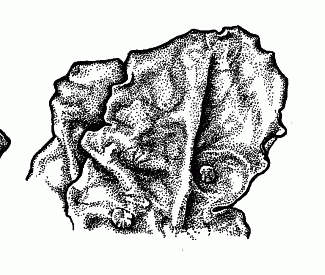Nephroma arcticum (L.) Torss.
Greenlight
Peltigeraceae
Introduction to the Lichens
Greenlight
Peltigeraceae
Introduction to the Lichens
Map
Distribution of Nephroma arcticum unavailable
Species Information
General:
Common Name: The Paw Lichens. Alludes to the presence of brown, paw-like apothecia on the lower surface; in all other genera the apothecia are located over the upper surface or along the lobe margins.
Small to medium or large stratified foliose lichens, corticate above and below, sorediate or isidiate or not, lobes loosely appressed to loosely attached, short to elongate, averaging to 0.5–2 (–3) cm wide, thin. Upper surface greenish, greyish or brownish, dull or shiny. Lower surface pale to dark, naked or more or less covered in dense woolly tomentum, occasionally also tuberculate, lacking rhizines. Medulla white (yellow to orange). Photobiont green and/or blue-green.
Apothecia appressed over lower surface near lobe tips, disc brown; spores 4-celled, spindle-shaped, pale brown, 8 per ascus.
Over trees, logs, mossy rocks.
Notes: Nephroma is a cosmopolitan genus of about 40 species worldwide. Nine are known from North America and all occur in B.C. Although thin-layer chromatography has been used successfully in the elucidation of some Nephroma species (see for example James and White 1987), spot tests are of little taxonomic value in this genus.
Species description:
Photobiont a grass-green alga; upper surface usually at least in part greenish (especially when wet: check sheltered lobes); soredia and isidia absent; over mossy rock or decaying logs; restricted to cool, snowy districts AND
Upper surface more or less shiny, mostly yellowish green; internal cephalodia visible from above as scattered darker patches; lower surface blackening toward thallus centre; apothecia common
OR
(blue-green phototype)
Photobiont a dark blue-green cyanobacterium; upper surface brownish, greyish, or if greenish, then also sorediate or isidiate; ecology and distribution various AND
Lower surface distinctly and more or less evenly covered in dense, woolly hairs, these tending to obscure the fine details of the surface wrinkles; soredia absent
Upper surface greyish, sparsely covered in minute, linear white markings/maculae; lower surface pale; rare AND
Lower surface whitish; lobe margins even; over mossy logs or ground
Comments:
Nephroma arcticum contains internal cephalodia that may occasionally develop into separate thalli of medium size. These thalli represent the blue-green phototype of Nephroma arcticum, which was recently detected in B.C. in humid intermontane forests (ICH zone) at lower elevations. Though closely resembling Nephroma silvae-veteris, it differs in having a chemistry identical to that of green N. arcticum (medulla K-, PD-) and in being attached to typical lobes of N. arcticum.
Reactions:
All spot tests negative.
Contents:
Both phototypes: nephroarctin, phenarctin, usnic acid, zeorin (and methyl gyrophorate).
Source: Lichens of British Columbia
Illustration

If more than one illustration is available for a species (e.g., separate illustrations were provided for two subspecies) then links to the separate images will be provided below. Note that individual subspecies or varietal illustrations are not always available.
Illustration By: Trevor Goward
Habitat and Range
Habitat: Frequent over moss and mossy rocks and logs in open upland sites throughout, especially in snowy districtsWorld Distribution: circumpolar, S to BC.
Source: Lichens of British Columbia